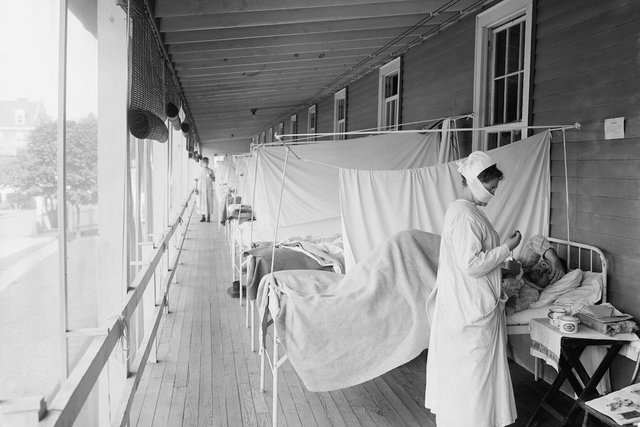The Spanish flu was a pandemic caused by the influenza virus between 1918 and 1920, during the First World War, leading to the death of more than 50 million people, affecting the entire world population.
Initially, the Spanish flu appeared only in Europe and the United States, but within a few months it spread to the rest of the world, affecting India, Southeast Asia, Japan, China, Central America and even Brazil, where it killed the most of 10 thousand people in Rio de Janeiro and 2 thousand in São Paulo.
There was no cure for the Spanish flu, but the disease disappeared between the end of 1919 and the beginning of 1920, and no more cases of the disease have been recorded since that time.

Spanish flu symptoms
The main symptoms of the Spanish flu included:
- Sudden onset fever, above 38º;
- Chills;
- Muscle and joint pain;
- Severe headache and body pain;
- Dry cough and sore throat;
- Stuffy nose;
- Inflammation of the larynx, pharynx, trachea and bronchi;
- Excessive tiredness and general malaise.
These symptoms, during the first wave of Spanish flu, improved after several days and the number of deaths was low.
However, in the second wave, the symptoms of the Spanish flu were more intense and progressed quickly, with the person experiencing brown spots on the face, bluish skin, coughing up blood and bleeding from the nose and ears.
Furthermore, the virus led to the development of complications such as fluid in the lungs, pneumonia or pulmonary edema, resulting in death from suffocation, within hours or days of the onset of infection.
Possible causes
The Spanish flu was caused by a random mutation in the flu virus, influenza A, which gave rise to the H1N1 virus. Understand what the H1N1 virus is.
Despite being known as the Spanish flu, this flu did not originate in Spain, having received this name due to the journalistic information sources at the time that covered news about the flu being mainly Spanish.
How the transmission took place
The Spanish flu virus was easily transmitted from person to person through direct contact, coughing and even through the air, mainly due to the health systems of several countries being deficient and suffering from the conflicts of the Great War.
How the treatment was carried out
No treatment was discovered for Spanish flu, and it was only advised to rest and maintain adequate nutrition and hydration. Thus, few patients were cured, depending on their immune system.
As there was no vaccine against the virus at the time, treatment was carried out to combat the symptoms and the doctor usually prescribed aspirin, an anti-inflammatory, to relieve pain and reduce fever.
However, the doses of this medicine were high, causing intoxication, called salicism, resulting in fluid accumulation in the lungs and pulmonary edema, worsening symptoms or leading to death from aspirin poisoning.
The mutation of the 1918 common flu virus is similar to the one that emerged in cases of bird flu (H5N1) or swine flu (H1N1). In these cases, as it was not easy to identify the organism that was causing the disease, it was not possible to find an effective treatment, making the disease fatal in most cases.
Spanish flu prevention
To avoid the transmission of the Spanish flu virus, it was recommended to avoid being in public places with lots of people, such as theaters or schools, and, therefore, some cities were abandoned.
Nowadays, the best way to prevent the flu is through annual vaccination, as viruses undergo random mutations throughout the year in order to survive. In addition to the vaccine, there are antibiotics, which appeared in 1928, and which can be prescribed by a doctor to prevent the occurrence of bacterial infections after the flu.
It is also important to avoid crowded environments, as the flu virus can easily pass from person to person. See how to prevent the flu.

Sign up for our newsletter and stay up to date with exclusive news
that can transform your routine!
Warning: Undefined array key "title" in /home/storelat/public_html/wp-content/plugins/link-whisper-premium/templates/frontend/related-posts.php on line 12
Warning: Undefined array key "title_tag" in /home/storelat/public_html/wp-content/plugins/link-whisper-premium/templates/frontend/related-posts.php on line 13



